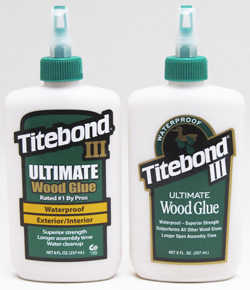
I suspect it is easier to find a needle in a haystack than to find a woodworker who does not use Titebond. After all, Titebond has been fulfilling our gluing needs since 1952. So what, after all this time, would make us switch to something else in record numbers?
The answer is Titebond III. Introduced in March of 2004, this new twist on an old favorite has been so well received that it threatens to eclipse the sales of its popular forebear by the end of this year. No wonder. Titebond III combines the strength, sandability, ease of use, and water cleanup of aliphatic resins, such as original Titebond, with the durability, longer open time, and water-resistance of polyurethanes.
“Titebond III is the first one-part wood glue to pass the ANSI Type I water resistance specification, and simultaneously offer a one year shelf life,” explained Mark Schroeder, Senior Marketing Manager of Franklin International, the company that makes Titebond. “As a result, we called it waterproof instead of water resistant.” For us woodworkers, that means we can now use our favorite glue for outdoor projects.
But that is not all. In addition to being waterproof, resistant to oil, solvents, heat, and mildew, and unaffected by finishes, it also boasts a longer open time. “A lot of feedback has shown us that users appreciate its longer open time,” said Schroeder. “It gives you 10 or 15 minutes, as opposed to only five or eight minutes for both original Titebond and Titebond II.” That’s a characteristic much appreciated by woodworkers struggling to assemble larger and more complex pieces before the glue sets up. Oddly enough, though, it cures just as fast, so no additional clamping time is needed. Not convinced yet? Titebond III also tolerates cold better, and can be used down to about 47 degrees F, a boon to those of us who work in cold garages and basements.
Great glue is nothing new to Franklin International, the third generation, family-owned business that makes Titebond. The owners’ last name, curiously enough, is Williams, not Franklin. No one seems to know the origin of the name Franklin for certain, though the company was founded, and still resides, in Columbus, Ohio, which is situated in Franklin County.
Franklin was started in 1935, During the depression, and from the beginning aimed its products at furniture manufacturers. At the time, hot hide glue reigned supreme. Franklin went a step better, by offering the first liquid hide glue on the market. Unlike hot hide glue, which must be heated all day, liquid hide glue is always ready-to-use right out of the bottle, and offers a longer assembly time as well. The fact that it could be used at room temperature eliminated much of the offensive odor associated with its heated predecessor.
Titebond, the first aliphatic resin glue of its kind, was introduced in the early 1950’s. Developed by owner Langdon Williams, along with one of the company chemists, it was quickly embraced by the woodworking world because it offered fast tack, faster cure, longer shelf life, and a longer open time. In short, it was more convenient and easier to use than hide glue, and its shorter clamp times translated into more profitable assembly schedules.
Then, in 1991, Franklin introduced Titebond II, which handled and acted about the same as the well-loved original, but offered greater water resistance. It was the first one-part PVA glue to pass the industry’s Type II water resistance test, admittedly a less stringent test than the Type I specification. It took a while, but eventually, Titebond II sales passed those of the original, and added quite a few new users as well.
Titebond is hardly the only product Franklin offers. Their 375 employees produce over 200 different adhesives and caulks for a variety of industries. Among those we woodworkers use are Titebond Dark, Titebond Molding and Trim glue, polyurethane adhesive, and the unusual HiPURformer, a hot-melt construction adhesive. And of course, they still sell liquid hide glue.
How does Titebond III compare to the polyurethane adhesives that have lately become so popular? Well, Titebond III is actually stronger than liquid polyurethane glues on wood to wood bonds. More importantly, it is easier to use, does not foam, does not stain fingers, has no health issues, cleans up with water, requires less clamp time, and is significantly less expensive than polyurethane glues. In short, it is stronger, safer, faster, and cheaper than liquid polyurethane. That’s a package that’s hard to beat.
“For the first time in history, woodworkers have a strong, convenient, waterproof glue that, ironically, cleans up with water,” Schroeder explained.
To us, it sounds like a woodworker’s fondest dream.





